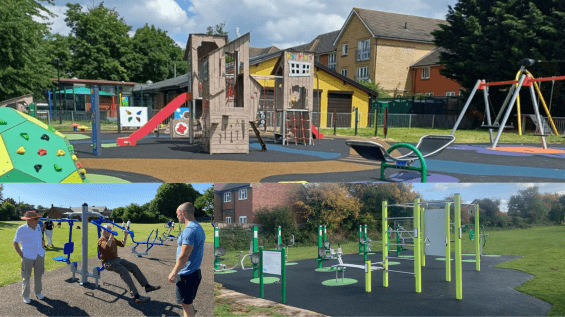
Oct

Outdoor Gym Equipment for Parks and Playground Equipment A Practical Guide for Councils
Parish and local councils play an important role in supporting the health and well-being of their communities. The spaces they manage are more than recreational amenities. Parks, playground equipment for parks, and outdoor gym equipment for parks provide residents with opportunities to be physically active, connect with others, and improve mental health.
When councils invest in outdoor spaces, they create environments that give children and adults a reason to be active and engaged. These facilities can build community pride and help meet wider public health goals. This blog explores why outdoor play and fitness matter, how they improve community health, and the steps councils can take to ensure long-term impact.
Why Outdoor Spaces Matter for Community Health
Physical inactivity is recognised as a serious public health challenge in the UK. According to Sport England, one in four adults in England does fewer than 30 minutes of physical activity a week, and inactivity is responsible for one in six deaths nationally. The estimated financial burden is £7.4 billion each year when health and wider societal costs are considered (Sport England, Inactive People).
For children, activity levels also remain a concern. The 2023–24 Active Lives Children and Young People Survey reported that only 47.8 percent of children and young people met the Chief Medical Officers’ recommendation of at least 60 minutes of daily physical activity (Sport England, Active Lives Children and Young People Survey 2023–24). This means more than half of children are not meeting the guidelines needed to support their development.
Outdoor spaces have the power to shift these figures. A park with quality play and gym equipment provides free and accessible opportunities for exercise at times that suit residents. Unlike gyms with membership fees or indoor facilities with limited opening times, local parks are inclusive spaces where all ages can take part.
Inspiring Activity Through Playground Equipment
For children, playgrounds are essential to their growth of children and provide benefits far beyond entertainment.
Encouraging Early Activity Habits
Equipment such as climbing frames, swings, and balance beams helps children develop strength, coordination, and confidence. These physical skills lay the foundation for future participation in sport and activity, and often influence habits that continue into adolescence and adulthood.
Building Social Value
Playgrounds are gathering places for families. They encourage children to form friendships and provide parents and carers with opportunities to connect. This sense of social value reduces isolation and strengthens neighbourhood bonds.
Supporting Inclusivity
Inclusive design is central to modern playgrounds. Ramps, sensory panels, and ground-level features allow children with different abilities to take part. An inclusive approach ensures that play areas are welcoming for everyone and increases community satisfaction with the facility.
By investing in inclusive equipment, councils demonstrate commitment to equality and ensure that public resources benefit the widest possible range of residents.
Outdoor Gyms as a Tool for Public Wellbeing
Outdoor gym equipment for parks is becoming an increasingly popular feature of community spaces. It offers a cost-effective way to encourage physical activity among adults, teenagers, and older residents.
Accessibility for All Ages
Outdoor gym equipment for parks is free to use and available all year round. This removes financial barriers and makes it possible for residents to exercise at times that fit their routine.
Supporting Health Outcomes
Regular use supports cardiovascular health, strength, and mobility. NHS guidance notes that adults should aim for at least 150 minutes of moderate intensity activity each week, or 75 minutes of vigorous activity, alongside muscle strengthening activities on two days (NHS Physical Activity Guidelines). For older people, low-impact equipment helps maintain independence and quality of life.
Alignment with Health Strategies
Councils that install outdoor gym equipment for parks contribute to national and regional efforts to reduce obesity, tackle inactivity, and improve mental health. These gyms also provide opportunities for group sessions or community challenges, which can boost participation and social cohesion.
A well-planned outdoor gym located near a play area can become a multi-generational hub where parents, grandparents, and young people all take part in activity together.
Surfacing and Safe Spaces for All Ages
Surfacing is a critical factor in ensuring outdoor spaces are safe and accessible.
Confidence and Safety
High-quality surfacing reduces the risk of injury and provides confidence for residents when using equipment. Surfaces that are even and slip-resistant encourage use, particularly among older adults and parents with young children.
Accessibility
Surfaces designed to support wheelchairs, mobility aids, and prams make parks inclusive for all users. Accessibility should extend beyond the equipment itself to the pathways and open spaces that connect facilities.
Durability
Long-lasting, low-maintenance surfacing reduces ongoing costs for councils. Investing in durable materials ensures that facilities remain open and safe without frequent disruption.
By considering surfacing as a foundation for design, councils can create outdoor environments that are practical, inclusive, and resilient.
Community Engagement Beyond Play and Fitness
Outdoor spaces are not only valuable for activity but also for the social role they play in community life.
Social Gathering Points
Playgrounds and gyms provide neutral spaces where residents of different ages and backgrounds come together. This interaction strengthens community identity and pride.
Events and Activities
Parks can host outdoor classes, wellbeing sessions, seasonal celebrations, and informal group activities. These events encourage the use of facilities and highlight the value of council investment.
Economic Benefits
Well-maintained parks attract visitors, which can increase footfall for nearby businesses. They also contribute to positive perceptions of neighbourhoods, making them more attractive places to live and work.
Visible investment in outdoor spaces demonstrates to residents that their council is committed to their well-being. This builds trust and encourages continued use and care of facilities.
Practical Steps for Councils
Successful outdoor play and fitness projects depend on careful planning and strategy.
Assess community needs: Consultation helps identify which facilities are most in demand and which groups are underserved.
Plan for inclusivity: Designs should accommodate children, teenagers, adults, and older residents, as well as those with different abilities.
Budget for the long term: Maintenance, replacement parts, and lifecycle costs should be considered alongside installation.
Link to health objectives: Demonstrating how a facility supports public health strategies can strengthen funding applications.
Monitor and evaluate: Collect feedback and usage data to measure success and guide future improvements.
How Caloo Supports Parish and Local Councils
Caloo has significant experience in working with parishes and local councils across the UK to deliver projects that meet local priorities.
Understanding objectives: Each project begins with listening. Whether the goal is to promote healthier lifestyles, provide inclusive play, or create a central gathering space, Caloo works to understand the vision.
Collaborative design: Proposals are developed in partnership with councils to ensure spaces reflect community needs and the character of the location.
Unique installations: No two communities are the same. Caloo delivers designs that are distinctive and engaging, encouraging high levels of use.
Full service support: From consultation and planning through to installation and maintenance, Caloo offers councils complete support.
Proven track record: By working with councils nationwide, Caloo has delivered safe, compliant, and innovative spaces that enrich local communities while meeting budget requirements.
This approach ensures that every project is more than an installation. It is an investment in the long-term well-being of residents and the cohesion of the community.
FAQs
What is the benefit of outdoor gyms for local communities?
They provide free fitness opportunities, encourage activity across generations, and contribute to public health targets.
How can councils fund new playgrounds and gyms?
Funding can come from council budgets, government grants, Section 106 agreements, or community fundraising.
What types of surfacing are best for parks?
Options include wet pour, bonded rubber mulch, and resin-bound surfacing. The choice depends on accessibility needs, safety requirements, and long-term maintenance considerations.
How do councils ensure inclusivity in playground design?
Incorporating sensory panels, wheelchair accessible equipment, and ground-level play features ensures children of all abilities can take part.
How can councils measure the impact of new facilities?
Usage surveys, feedback from residents, and analysis of health statistics help track the success of projects.
What role do residents play in the design process?
Consulting residents ensures facilities reflect local needs and encourages a sense of ownership within the community.
Outdoor play and fitness spaces are valuable tools for improving health, fostering connections, and building vibrant communities. Councils that invest in these areas create immediate opportunities for activity and social engagement, while also laying foundations for long-term wellbeing.
Considering new playground equipment for parks, outdoor gym equipment for parks, or surfacing solutions, Caloo can help you bring your vision to life. Speak to our team to explore tailored designs that support healthier, happier communities.
References
Sport England. Inactive People. “One in four adults in England does fewer than 30 minutes of physical activity a week. One in six deaths is caused by inactivity. Estimated cost £7.4 billion annually.”
Sport England. Active Lives Children and Young People Survey 2023–24. “47.8 percent of children met the guideline of 60 minutes of activity per day.”
NHS. Physical Activity Guidelines for Adults Aged 19 to 64. “Adults should aim for at least 150 minutes of moderate intensity activity each week.”

















